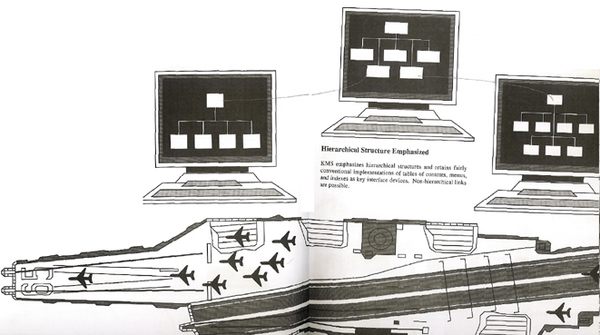11.2.4 Knowldege Management System (Newell u.a. 1972)



KMS (1983)
KMS probably has the distinction of being the oldest among the currently popular hypertext systems since it is a direct descendant of the ZOG research system developed at Carnegie Mellon University with some development as early as 1972 and as a full-scale project from 1975 [Robertson et al. 1981]. The word ZOG does not mean anything but was chosen because it "is short, easily pronounced and easily remembered." At first, ZOG ran on mainframe computers; it was then moved to PERQ workstations, 28 of which were installed on the aircraft carrier USS Carl Vinson in 1983 for a field test of such applications as a maintenance manual for weapons elevators.
KMS is an abbreviation for Knowledge Management System and has been a commercial product since 1983. It runs on Unix workstations and has been used for a large number of applications. KMS is designed to manage fairly large hypertexts with many tens of thousands of nodes and has been designed from the start to work across local area networks.
KMS has a very simple data structure based on a single type of node called the frame. A frame can take over the entire workstation screen, but normally the screen is split into two frames, each of which is about as big as a letter-sized page of paper. Users cannot mix small and large nodes and cannot have more than two nodes on the screen at the same time. This might seem limiting at first but proponents of KMS claim that it is much better to use the hypertext navigation mechanism to change the contents of the display than to have to use window management operations to find the desired information among many overlapping windows.
KMS has been optimized for speed of navigation, so the destination frame will normally be displayed "instantaneously" as the user clicks the mouse on an anchor. The time to display a new frame is actually about a half-second, and the designers of KMS claim that there is no real benefit to being faster than that. They tried an experimental system to change the display in 0.05 seconds, but that was so fast that users had trouble noticing whether or not the screen had changed.
If an item on the screen is not linked to another node, then clicking on it will generate an empty frame, making node and link creation seem like a special form of navigation to the user. It is also possible for a click on an item to run a small program written in the special KMS action language. This language is not quite as general as the integrated InterLisp in NoteCards, but it still allows the user to customize KMS for many special applications. See for example the discussion in Chapter 4 of the use of KMS to support the research of a biologist.
KMS does not provide an overview diagram but instead relies on fast navigation and a hierarchical structure of the nodes. Links across the hierarchy are prefixed with an "@" to let users know that they are moving to another part of the information space. Two additional facilities to help users navigate are the landmark status of a special "home" frame, which is directly accessible from any location, and the special ease and global availability of backtracking to the previous node by single-clicking the mouse as long as it points to empty space on the screen.
